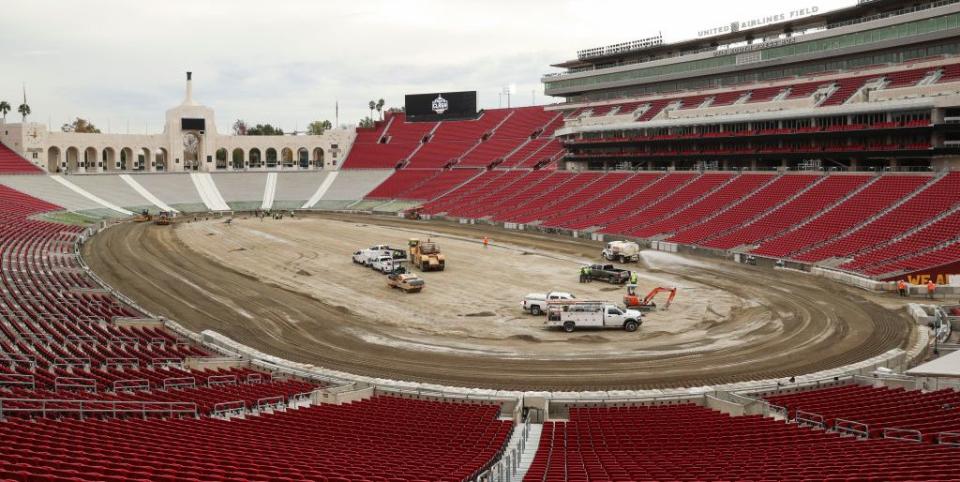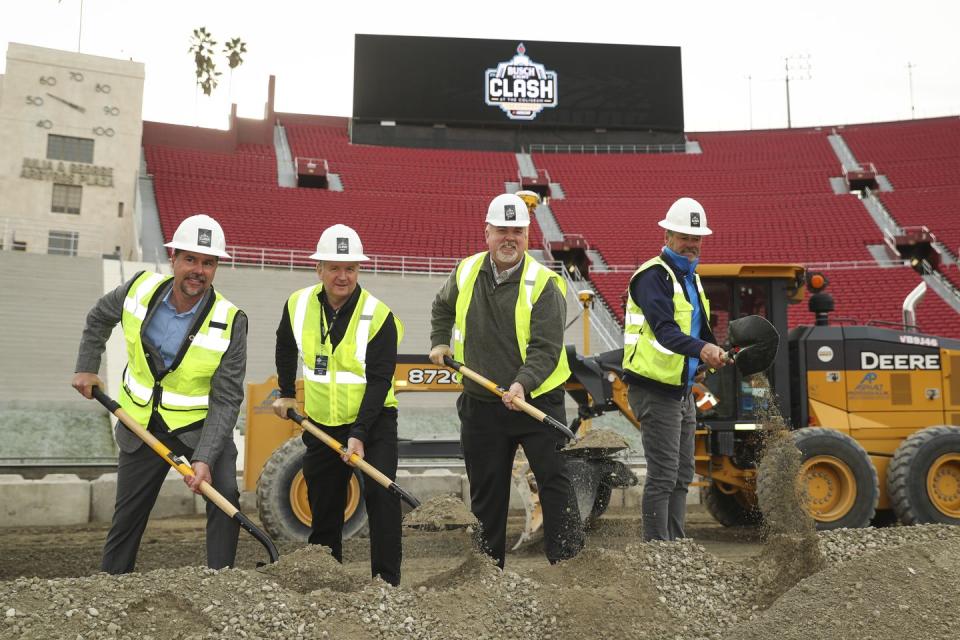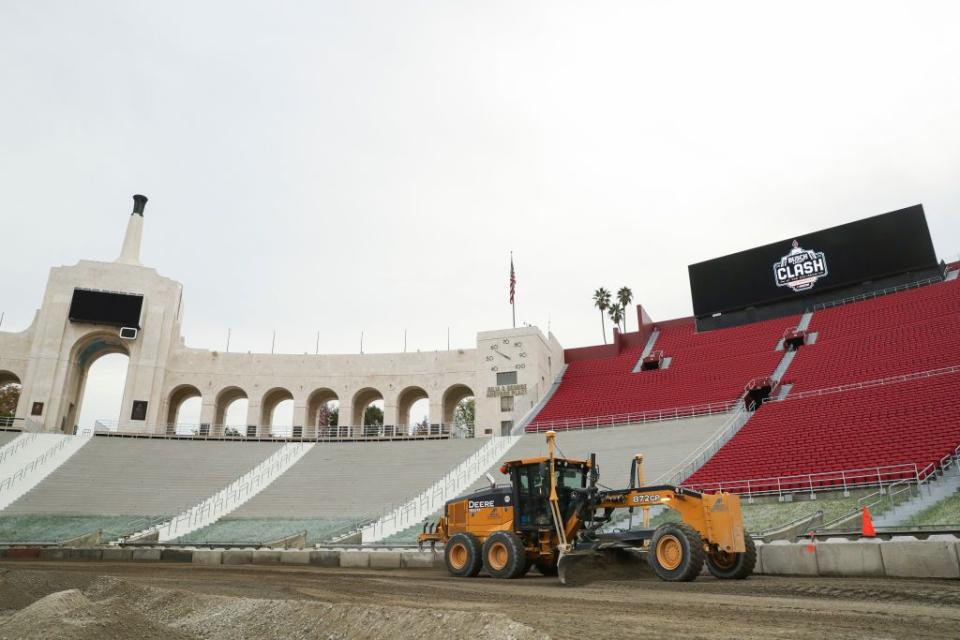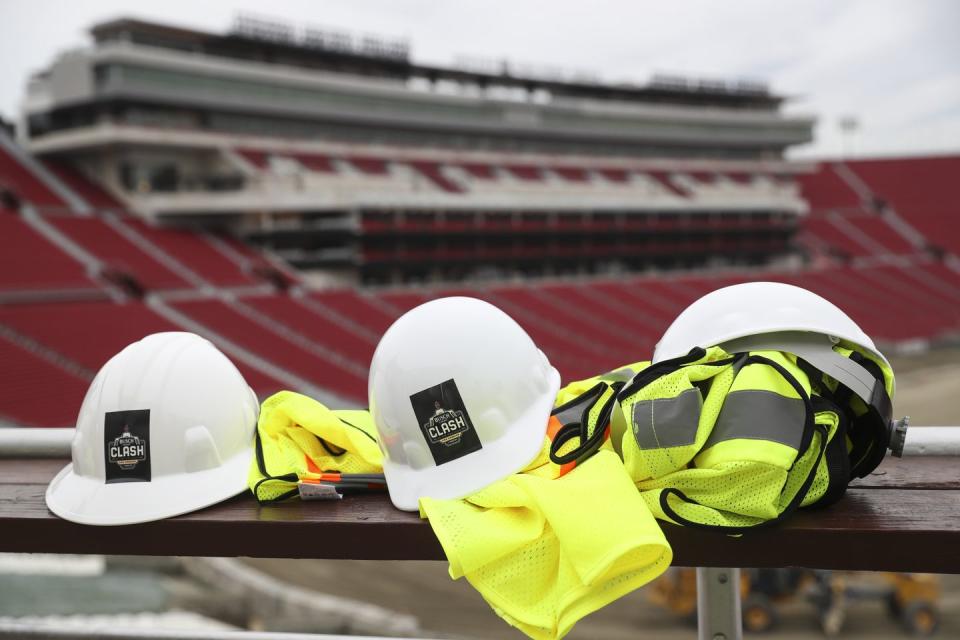Why NASCAR Going to the LA Memorial Coliseum Is Bananas ... and Brilliant

There are some questions inside and outside the sport concerning NASCAR’s ability to stage an entertaining, competitive, season-opening race with big Cup cars on a tiny, inside-a-stadium track.
Over the past 70 years, NASCAR has deployed its race cars to some unusual landscapes, including Soldier Field in Chicago.
In 2022, Cup drivers will race under the shadow of the unique peristyle in the eastern end of the stadium.
Over the past 70 years, NASCAR has deployed its race cars to some unusual landscapes, including Soldier Field in Chicago, a minor league baseball stadium in Asheville, N.C., a combination beach-road course in Daytona Beach, Fla. and even a rodeo site in Tucson, Ariz.
February, however, presents a whole new animal.
A race host of near-biblical proportions and history. A venue that will put the NASCAR name, however oddly, on a list that contains most major sporting endeavors and more than a few iconic moments far beyond the fences and limits of mere sport.
Welcome to the Los Angeles Memorial Coliseum.
NASCAR has scheduled the Busch Light Clash, the annual non-points race that begins the Cup season, at the coliseum Feb. 6. On a purpose-built quarter-mile asphalt track that will circle the stadium’s football field, NASCAR’s best will compete in a facility that has hosted, to name a very few of the many big names, Bart Starr, Sandy Koufax, Carl Lewis, Lynn Swann, Billy Graham, John F. Kennedy, the Rolling Stones, Bruce Springsteen and Pope John Paul II.
“It’s one of the oldest continually operating stadiums in the country and no doubt a cultural touchstone,” said David Israel, former president of the coliseum commission. “It’s held more important events than most other places, and now NASCAR, which is kind of mind-blowing. How are they going to pull that off?”

Israel, a former sports writer who has visited most of the major sports facilities in the country, puts the coliseum on a list of sports icons that also includes Notre Dame Stadium, Fenway Park, the old Yankee Stadium, Wrigley Field and the old Madison Square Garden in New York.
“Stadiums just don’t look like that anymore,” he said. “The fact that the coliseum has endured in this time of everybody trying to make everything look the same is incredible.”
An elongated stadium that was regal in its youth and remains so, the coliseum opened in 1923 and can boast of numerous distinctions and events: Summer Olympics (1932 and 1984, and scheduled again in 2028), Super Bowl (twice), World Series (once), Southern Cal home football, Los Angeles Rams, Oakland Raiders, Los Angeles Dodgers, Billy Graham Crusade (record 134,254 attendance), concerts by the Stones, U2, the Who, Springsteen and numerous other headliners and JFK’s acceptance speech at the 1960 Democratic National Convention.
It’s almost like NASCAR was needed to complete the loop of history.
“It’s unlike any other place I’ve ever played,” said Shaun Cody, who played for four years (2001-04) at the coliseum as a tackle for Southern Cal. “I’ve played all over the country, and it’s a special place. The amount of people you can stack in there when you have a great event or a big sporting activity is just crazy.”

Cody, who played in the National Football League for Detroit and Houston, said entering the field from the huge tunnel at one end of the coliseum is an experience that can’t be duplicated.
“The first time I walked out of the tunnel there, I remember how that felt,” he said. “I thought about all the celebrities and important people who had walked out there. You feel like some kind of rock star walking out on that stage.”
As for NASCAR?
“It sounds bananas,” Cody said. “It should be a hell of a lot of fun. I’m sure it will be insane.”
Cup drivers will race under the shadow of the unique peristyle in the eastern end of the stadium. That feature holds the pedestal for the Olympic torch and includes a series of arches and the five Olympic rings.
“The stadium architecture is relevant because of the peristyle end,” Israel said. “The stadium was built because Los Angeles wanted to assert itself as a big-time city. It’s where the westward expansion of sports occurred with the USC-Notre Dame game and the Dodgers. It’s where American sports became continental with the move of the Dodgers (from Brooklyn).”

There are some questions inside and outside the sport concerning NASCAR’s ability to stage an entertaining, competitive, season-opening race with big Cup cars on a tiny, inside-a-stadium track. The Clash, after all, has been held in the wide open spaces of Daytona International Speedway since 1979.
But the novelty of the event – and the unusual, National Historic Landmark site – is expected to draw considerable attendance and possibly elevate television ratings. Plus, it doesn’t hurt that the Super Bowl – and all its attendant publicity and hoopla -- is scheduled a week later in LA (although at SoFi Stadium, not the coliseum).

 Yahoo Autos
Yahoo Autos 